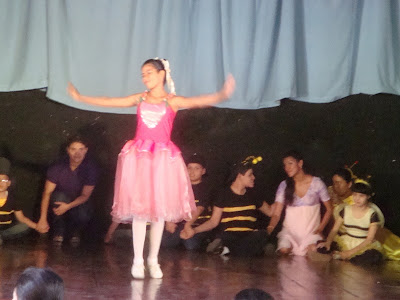Since the Sandinista Revolution, Nicaragua has been marked by projects which reach the most remote corners of the society and involve people in self-realization, community growth, and economic development in unique ways. One "corner" of society which almost always remains at the back of the priorities in a poor society is that of disabled people. Many people living in a country as poor as Nicaragua find life too burdensome and resources too scarce to get help with their handicapped family members. Far too often, the world of a person facing some disability revolves around the television and the back patio of the home, because all the other members of the family are struggling to put food on the table.
Our friend Patricia Lopez directs an organization which addresses the needs of people with special needs in Managua. Asociacion Psicoballet Nicaragua offers physical and mental stimulation for disabled people, at prices scaled to the family economy of each participant. Many participants receive complete scholarships, because their families are disintegrated and without gainful employment. Others pay a small amount, in accordance with their self-declared capacity.
This past December, a gala performance by the young (and young-at-heart) members of this group was held in downtown Managua. The performers in costume performed their choreographed dances as parents, friends and allies watched. The students of Apoyo Spanish School made a special excursion to see this event, and Joyce Procure took photos and video shown here.
The challenges facing the participants of the gala are numerous, diverse, and in many cases, severe. But in each case, they could express themselves, with hands and feet, or if not, with their faces and eyes. The members of this group, with different kinds and severity of disabilities, learn to express themselves instead of hide, and to encourage and help one another.
Participation in an event like this just does not happen for children with disabilities in Nicaragua, unless of course their parents are millionaires. Thanks to Psicoballet Nicaragua, many young people who never exercise or express themselves, enjoy involvement in activities that those of us without disabilities may take for granted. These young people participate in a program of movement, exercise, and rhythm, where they learn to value their bodies just as they are, and to express themselves in movement. As the photos and video below demonstrate, these young people have great pride in themselves, as they performed on stage.
Each participant is facing a different challenge. Some have paralysis, others autism, schizophrenia or Down's syndrome. Some face challenges without names found in textbooks. All of them come from families who can't afford 24-hour, professional attention to their children's needs. Many of the parents are just barely getting food to the table for their families, and the majority of the families are broken. Asociacion Psicoballet Nicaragua gives the children in these settings opportunities within the possibilities that their families encounter.
Psicoballet Nicaragua is opening up a new dimension in the lives of handicapped people in Nicaragua. We are proud of them, because they help to make Nicaragua a happy place for some of the people too easily forgotten in our society. Following are several wonderful videos made by Joyce Procure, of the Gala 2012 in Downtown Managua.
Our friend Patricia Lopez directs an organization which addresses the needs of people with special needs in Managua. Asociacion Psicoballet Nicaragua offers physical and mental stimulation for disabled people, at prices scaled to the family economy of each participant. Many participants receive complete scholarships, because their families are disintegrated and without gainful employment. Others pay a small amount, in accordance with their self-declared capacity.
This past December, a gala performance by the young (and young-at-heart) members of this group was held in downtown Managua. The performers in costume performed their choreographed dances as parents, friends and allies watched. The students of Apoyo Spanish School made a special excursion to see this event, and Joyce Procure took photos and video shown here.
The challenges facing the participants of the gala are numerous, diverse, and in many cases, severe. But in each case, they could express themselves, with hands and feet, or if not, with their faces and eyes. The members of this group, with different kinds and severity of disabilities, learn to express themselves instead of hide, and to encourage and help one another.
Participation in an event like this just does not happen for children with disabilities in Nicaragua, unless of course their parents are millionaires. Thanks to Psicoballet Nicaragua, many young people who never exercise or express themselves, enjoy involvement in activities that those of us without disabilities may take for granted. These young people participate in a program of movement, exercise, and rhythm, where they learn to value their bodies just as they are, and to express themselves in movement. As the photos and video below demonstrate, these young people have great pride in themselves, as they performed on stage.
Each participant is facing a different challenge. Some have paralysis, others autism, schizophrenia or Down's syndrome. Some face challenges without names found in textbooks. All of them come from families who can't afford 24-hour, professional attention to their children's needs. Many of the parents are just barely getting food to the table for their families, and the majority of the families are broken. Asociacion Psicoballet Nicaragua gives the children in these settings opportunities within the possibilities that their families encounter.
Psicoballet Nicaragua is opening up a new dimension in the lives of handicapped people in Nicaragua. We are proud of them, because they help to make Nicaragua a happy place for some of the people too easily forgotten in our society. Following are several wonderful videos made by Joyce Procure, of the Gala 2012 in Downtown Managua.
 |
| Click on the "escudo" to contact us. |
















